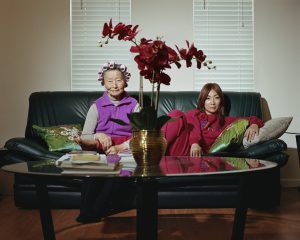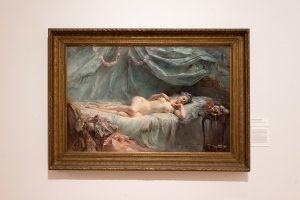Hannah Dunsirn is a photography student at Columbia College, RAW artist, portrait photographer extraordinaire, and an all-around lovely person. Hailing from a small town in Northeast Wisconsin, Hannah came to Chicago in 2009 to pursue her love for photography. Hannah was recently featured at the RAW: Natural Born Artists September showcase, “Ensemble,” where she showed a beautiful series of photographs taken while traveling in India this past summer. Past projects of hers explore the idea of personal identity and the process of adapting and changing the surrounding environment to one’s own, such as a place of employment. Hannah is also deeply inspired by travel, as many of her photos reflect the discovery of new places, people and culture. She has also made a zine featuring her series from India, and plans to continue to make zines in the future.
I met with Hannah at Cafecito in the South Loop, where we both enjoyed a delicious sandwich and chatted. We discussed how she got started, her inspirations, her time at Columbia, and her plans for the future

Lydia Shepard (LS): What drew you to photography in the first place?
Hannah Dunsirn (HD): When I was in eighth grade, my parents sent me to an art camp. Every summer since I would go to pre-colleges, which is like an art camp but at colleges. I did a few summers at MIAD in Milwaukee, one summer at RMCAD in Colorado, and one summer at MCAD in Minnesota. So ever since eighth grade, that is what got me started taking photos every summer. I really enjoyed them. I took these summer programs seriously because they treated you like college students, and you stayed in the dorms. That is what made me realize that I wanted to go to an art school.
LS: What has your experience as a student at Columbia been like?
HD: It’s great. Columbia offers [students] so much that has to do with the real world. That is what brought me to Columbia instead of going to a smaller art school. They bring in real photographers to talk to students. You get a lot of great connections through Columbia, and that is what I love about it. It has gotten me to meet a lot of great professionals.

LS: What are your thoughts on the Photo program at Columbia?
HD: I absolutely love it. I’ve been working in the digital lab for the past two years helping people with Photoshop and printing. That has made me really close with some of the professors, which has been amazing. I feel like I got here at the right time. There used to be two buildings to shoot in, and now, due to budget cuts, there is one and it’s always packed. They are getting rid of the dark room. [The photo department] is at this transition point where incoming students are no longer taking darkroom classes, and instead they are going straight to digital. You used to have to take a darkroom class. So now, they have teachers who used to teach darkroom who are now teaching digital. It’s kind of hard on incoming students, because these teachers are amazing photographers on film.
LS: Are you primarily digital?
HD: Yeah, I’m primarily digital. What I consider some of my “fine art” photography is film. I use a 4×5 large format camera, then develop the negatives and scan them digitally.

LS: What are some things that inspire your photography?
HD: Travel, big time, and also my friends. I don’t know what it is about my friends. They just have such unique personalities, and it has inspired me to do different projects about them. That is what a lot of my 4×5 work is about.
LS: That reminds me of your series, “Identity.” What were you getting at with that series?
HD: My influence for that project was a photographer named August Sander. He took portraits of all sorts of people, like factory workers, and would title the photo “Factory Worker.” This project was about my friends who are at this weird stage of college where you should know what you are doing. You should know who you are, but when do you really figure that out? Another thing that interested me is the way that they show their identity through their clothing. They all have very unique clothing and they put off this persona through what they are wearing, their stances, and their reliance on other people. That is what interested me.
LS: Tell me about the “Workspaces” Project.

HD: I was going through this factory in Neenah, and I thought it was interesting how everyone personalizes their workspace. It’s not like a cubical where people have nice little frames. These people have stickers and pictures of them hunting taped on to their lockers and stuff like that. I found it really interesting that no matter where people are, they make it a home. That project was primarily looking at how people interact with their space.
LS: You mentioned travel as being a big influence. Is there somewhere that you really want to go?
HD: Everywhere. Part of what I like about traveling is that, unlike here where I feel weird going up to strangers to take pictures, you are an outsider looking in and they get that. That’s what I like to do especially, look at people from other places and take their portraits. There isn’t a specific place that I have in mind that I would like to go, I would just like to go anywhere.
LS: Have you been or are you currently involved in any group projects or exhibitions?
HD: My work wasn’t in it, but I was involved with the Hokin Project. I just helped with installation, I had a say in the curating. It’s a student-gallery for a class, but it gives you the opportunity to run your own gallery. That’s what’s neat about it.

LS: How was your experience with RAW?
HD: It was good. It was fun, and I got to talk to people who were really interested. There aren’t art teachers from Columbia coming; the whole audience was just family and friends of other artists. They would come and look at my work, and they would seem really interested and it was great to talk to them. My favorite part was that I got to meet some people from India who got to see my India work, and it was really fun talking to them about it. It’s more of a fun thing and not a place to meet potential buyers or people who will get your work in a gallery. It was a little disappointing in that realm, but otherwise it was fun. It’s good to have the experience of showing your work and talking about it to other people.
LS: Any future projects or plans?
HD: Right now I am working on video work. I’m in a portrait class and I feel like I have done so many portraits. So now, I am doing portrait videos. I’m really excited about it. There will be studio lighting and I’ll take portraits of the model, talk to them, and have them basically unaware that there’s a video being taken. So when I step away from the camera and speak to them, they drop that wall and they can just relax and talk to me. I’m taking some of those videos, slowing them down, taking certain parts that are real and not so posed. That is a whole project that I’m working on. Future plans? To get some more work out and graduate.
LS: Does Columbia easily allow for that kind of interdisciplinary work, like using video in the photo department?
HD: Yeah. It’s actually changed a lot. There are some teachers that are absolutely thrilled with the idea; they tell you to push it, step out of the box, and do some other work. I know a lot of people who are doing sculpture now, who are also still in the photo department, they are just incorporating that into their photography. It is becoming really versatile, which is nice.
LS: You put out a zine for the RAW show. Are you going to keep doing those?
HD: I’ll make more. They’re easy to make and they’re fun, so I’ll definitely keep doing more of those for other projects. I’m eventually going to have something up on my website where you can just click on it and buy a zine through PayPal.
All images in this article courtesy of Hannah Dunsirn. To learn more about Hannah Dunsirn, visit her website here.



